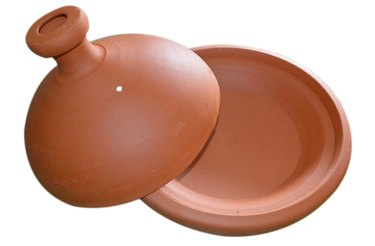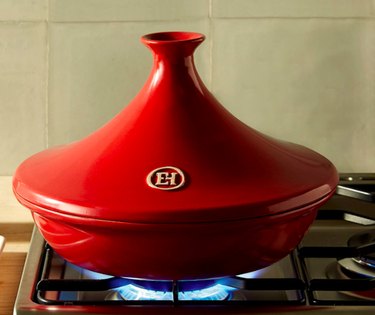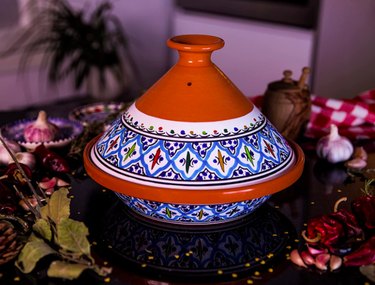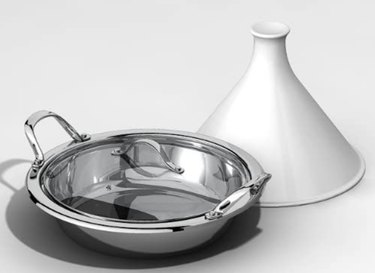
If the word "tagine" (sometimes spelled "tajine") is new to you, you've just stumbled upon a great new piece of cookware for your kitchen. Used to cook the Moroccan stew-like dish of the same name, these conical or dome-shaped cooking vessels work similarly to Dutch ovens or slow-cookers, but require less liquid. Composed of a wide, shallow circular dish at the bottom and a distinctively-shaped cone or dome on top (the purpose of which is to return moisture to the base of the tagine), tagines are excellent for cooking rich, flavorful and moist stews, vegetable and rice dishes, and couscous.
Tagines have historically been crafted out of clay or ceramic, but it's not uncommon to see modern tagines (especially Western-made ones) made from other materials, such as stainless steel or cast-iron. In addition to the different materials and option of glazed or unglazed, tagines also vary in size. If you're so far intrigued, we've laid out what to consider when purchasing a tagine and selected the best tagines in 2022.
Video of the Day
Video of the Day
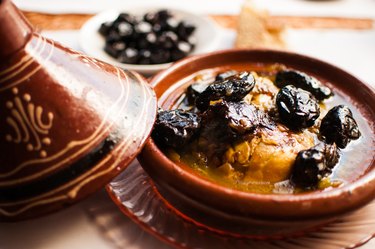
What to Consider When Purchasing a Tagine
Materials: Traditional tagines are handmade from clay. While clay is the original material of choice, it does present some potential drawbacks to modern home cooks who are used to cooking with other materials. For example, clay is much more fragile than, say, stainless steel. Additionally, clay cooking vessels don't have as high of a heating threshold as other materials, so cooking takes longer because it has to be done at lower temperatures.
If you're willing to trade a bit of authenticity for modern functionality, alternative materials like stainless steel or cast-iron work well because of their durability and ability to withstand much higher temperatures. Cast-iron will be the most expensive, but will undoubtedly be long-lasting. Aluminium is another option that's less expensive, not to mention lightweight and portable, making it a good choice for camping. However, aluminum tagines work better for ingredients that cook quickly, such as fish, rather than for slow-roasting large cuts of meat. You're also less likely to find aluminum tagines online; they're more common in Morocco.
Glazed Versus Unglazed: If you do go for a clay tagine, there are glazed and unglazed options. Classic clay tagines are usually unglazed, which can contribute an earthy flavor to whatever dish you cook. In fact, the porous nature of an unglazed tagine allows it to absorb flavor with each subsequent dish you prepare, so your cooking can become even more flavorful the more you use it.
Tagine purists will stand by the choice to leave them unglazed in order to get that authentic Moroccan essence, but depending on your taste, this can be a good or bad thing. Glazed tagines will largely eliminate this factor. Unglazed tagines are a bit trickier to use because they have to be soaked in water and then oiled before cooking. They also have to be cooked slowly at low temperatures. Food is also more susceptible to burning in an unglazed tagine if you don't keep an eye on it. Glazed tagines are more resistant to burning food, but it's still a good idea to soak them before cooking to avoid cracking.
- One extremely important thing to confirm before cooking in a glazed tagine is that it's been fired with a lead-free glaze. For imported glazed tagines, we don't recommend relying on the label or sticker alone. It would be wise to use a portable lead testing kit (available at Amazon) to be sure.
Hole Versus No Hole: On modern manufactured tagines, you may find a hole in the top of the conical or dome-shaped lid. It's intended to serve as a steam vent during cooking, since manufactured tagines are much more likely to have a bottom and lid that fit tightly together. Traditional handmade clay tagines, however, usually don't have a hole in the lid because they're less perfectly formed, so steam may naturally get released in small amounts through slight gaps in the seal.
To some, the hole is counterintuitive because it may lead to too much loss of moisture and result in longer cooking times, while to others, it's favorable. Traditionalists say nay to the hole, but they're more likely to be using handmade tagines, which tend to already release some steam. You'd mainly want to avoid a handmade clay tagine that also features a hole, but those are rare, anyway.
Function: For the most part, we're talking about tagines meant for cooking, but there are also tagines meant for serving food instead of cooking. If you've ever seen colorful, more elaborately decorated and enameled tagines in the marketplace, chances are, these are serving tagines that are meant to look beautiful but not designed to stand up to high cooking temperatures. They're also more likely to contain lead. Avoid cooking in a serving tagine because it can be unsafe. Keep in mind what function you're looking for when shopping for a tagine and double-check to make sure you're buying the right kind for your needs.
Size: Tagines vary in size, so it's really down to your preferences. Most tagines fall between 1 quart and 4 quarts in capacity. You can also think of them in terms of serving size. Smaller tagines may cook enough for one or two servings, while larger ones may serve up to six or eight people. For some tagines, only the diameter of the base is listed. As a rule of thumb, 8 inches to 10 inches in diameter will be enough to serve two people. Consider the size of your household and which dishes you'll likely be preparing most. If you've got a large family, you may need multiple tagines to adequately feed everyone.
With these considerations in mind, we've selected the best cooking tagines in 2022:

The Best Overall Tagine
Le Creuset Enameled Cast-Iron Moroccan Tagine
Le Creuset is definitely a contender when it comes to the best cookware, and their take on the tagine is no exception. The base is made from enameled cast-iron—meaning it's safe to use on any cooktop, including induction and glass-top stoves as well as in the oven—while its conical lid is made from colorful ceramic. The lid does include a hole in the top, but because the lid and base form such a tight seal, it's arguably necessary to allow for a bit of steam release. Overall, the lid locks in moisture and heat so your stews and vegetable dishes will come out impeccably.
The tagine is safe up to 500 degrees Fahrenheit and doesn't require pre-seasoning. It offers a 2 1/2-quart capacity, which is usually enough for a family of four. The only real downside is its steep price tag, but it's worth it because it will last for years and years. Another thing to remember is that because it's glazed, it won't absorb flavors and enhance your cooking with authentic earthy tastes, but for some, that's not a bad thing.
Runner-Up Best Tagine
Uno Casa Cast-Iron and Ceramic Cooking Tagine
Another excellent choice—for a fraction of the cost—is the cooking tagine from Uno Casa. Like its Le Creuset competitor, it consists of a cast-iron pot and ceramic lid. The pot is nonstick and its enameled cast-iron construction makes it ideal for slow-cooking without the likelihood of burning. It's also versatile on all types of cooktops and safe in the oven up to 500 degrees Fahrenheit. The tagine comes in a bright red color and boasts a generous 3.65-quart capacity, enough for about six or more servings. Uno Casa also includes a Moroccan recipe eBook and two oven mitts to help you get started.
The Best Unglazed Tagine
Moroccan Large Lead-Free Non-Glazed Cooking Tagine
Traditional unglazed tagines are harder to come by online, but this one by Treasures of Morocco is as close to a simple, authentic clay tagine you'd find in a Moroccan marketplace as any (it's actually handcrafted in Morocco). It's pretty plain (it's just the standard brown color of clay), but what it sacrifices in ornamental beauty, it makes up for in functionality and flavor with the ability to impart the earthy flavors of Moroccan dishes that tagine aficionados are so fond of. Its dome-shaped lid provides extra room for ingredients compared to more slender conical lids, and there's no hole to be found in the handle—all the better to retain that delicious moisture and flavor.
The only caveat (or a plus, depending on how you look at it) is that because it's unglazed and made of clay, it has to be cooked slowly at low temperatures for a longer period of time (this is important to avoid cracking). It measures approximately 12 inches at the base.
Tip
For best results with a traditional unglazed Moroccan tagine, season it before its first use (and again if it sits unused for approximately a year). Avoid subjecting the tagine to drastic changes in temperature, including where you set it down, as this can cause thermal shock and lead to cracks. You should also avoid using strong soap products or detergents on it while cleaning—water and baking soda is preferred.
The Best Glazed Tagine
Emile Henry Flame Ceramic Tagine
If you prefer your cookware glazed, this 3.7-quart glazed ceramic tagine by Emile Henry has much to admire. Its patented Flame® Ceramic technology enables it to withstand very high temperatures and use less oil at the same time. Despite this, the French manufacturer still recommends using it more like a traditional tagine, meaning simmering over low heat for a longer period of time (which is better for the flavor, anyway). You don't have to worry about thermal shock, however. Moreover, its sloped lid (which contains no hole) allows steam to circulate and keep food tender and moist. The tagine is safe to use on all direct heat sources like gas, induction and halogen, as well as in the oven.
The Best Ceramic Tagine
Kamsah Handmade and Hand-Painted Tagine
These beautiful ceramic tagines are handmade and hand-painted by women in Tunisia, which has been well-known for its ceramics for hundreds of years. They are fair trade products. Available in small and large sizes, each tagine measures either 10 inches tall and 10 inches in diameter at the base, or 12 inches tall and 12 inches in diameter. Every tagine features an elegant, hand-painted turquoise pattern on both the base and lid. It's safe to use on gas and electric stoves at temperatures up to 275 degrees Fahrenheit, but make sure to use a heat diffuser and first start at a very low temperature before gradually increasing the heat. You should also soak the tagine in cold water for 36 hours before using it for the first time.
The Best Stainless Steel Tagine
Cooks Standard Stainless Steel Tagine
This multi-ply stainless steel tagine comes with both a ceramic lid for more traditional Moroccan- and North African-style cooking, as well as a tempered glass lid that allows you to use the stainless steel and aluminum core base for more conventional stovetop or oven roasting. It's safe to use on all types of cooktops, including glass, ceramic and induction, and it's oven-safe up to 500 degrees Fahrenheit. No heat diffuser is necessary when using it on the stove.
The base features two looped handles that provide an easy and firm grip when handling it (a model without handles is sometimes available). The base is also dishwasher-safe, so cleaning is easier than it is for other tagines. It boasts a generous 4 1/2-quart capacity. Overall, it's a durable and multi-functional piece of cookware that ranks among the best for home use.


